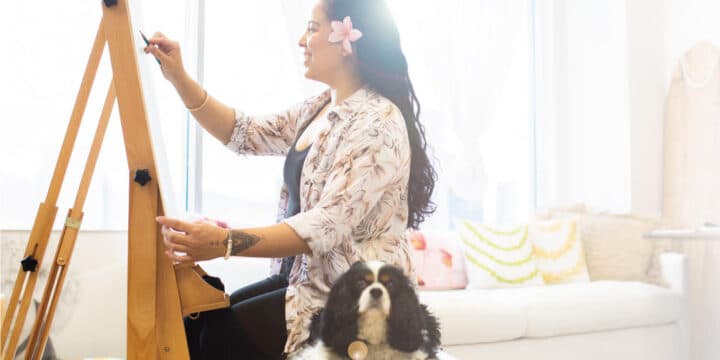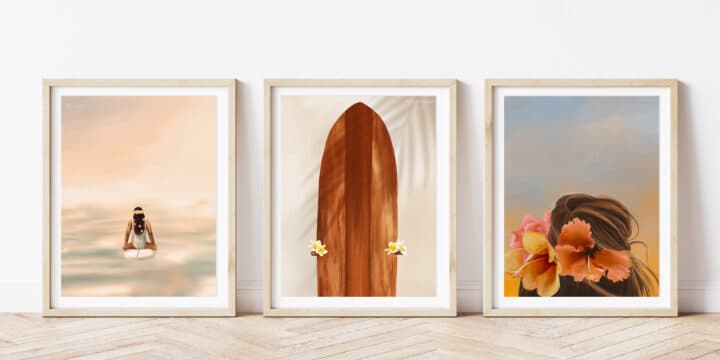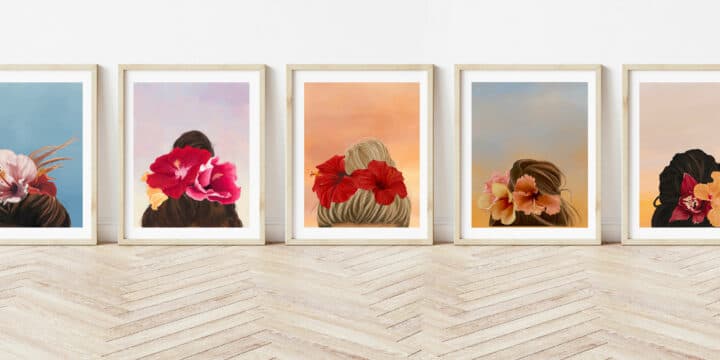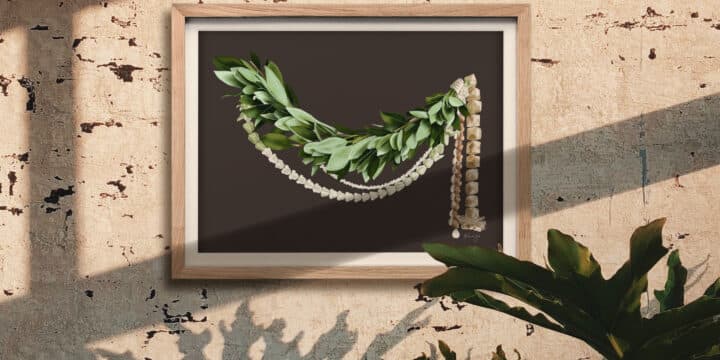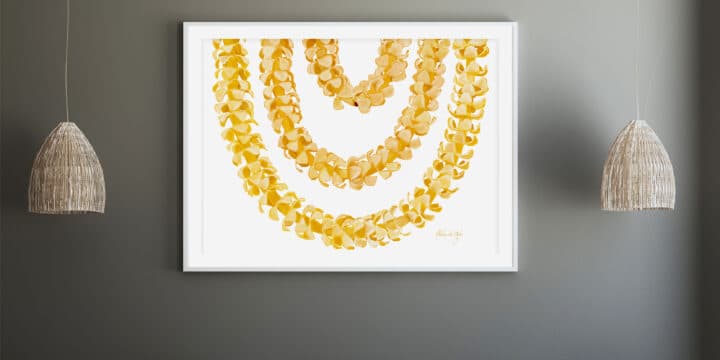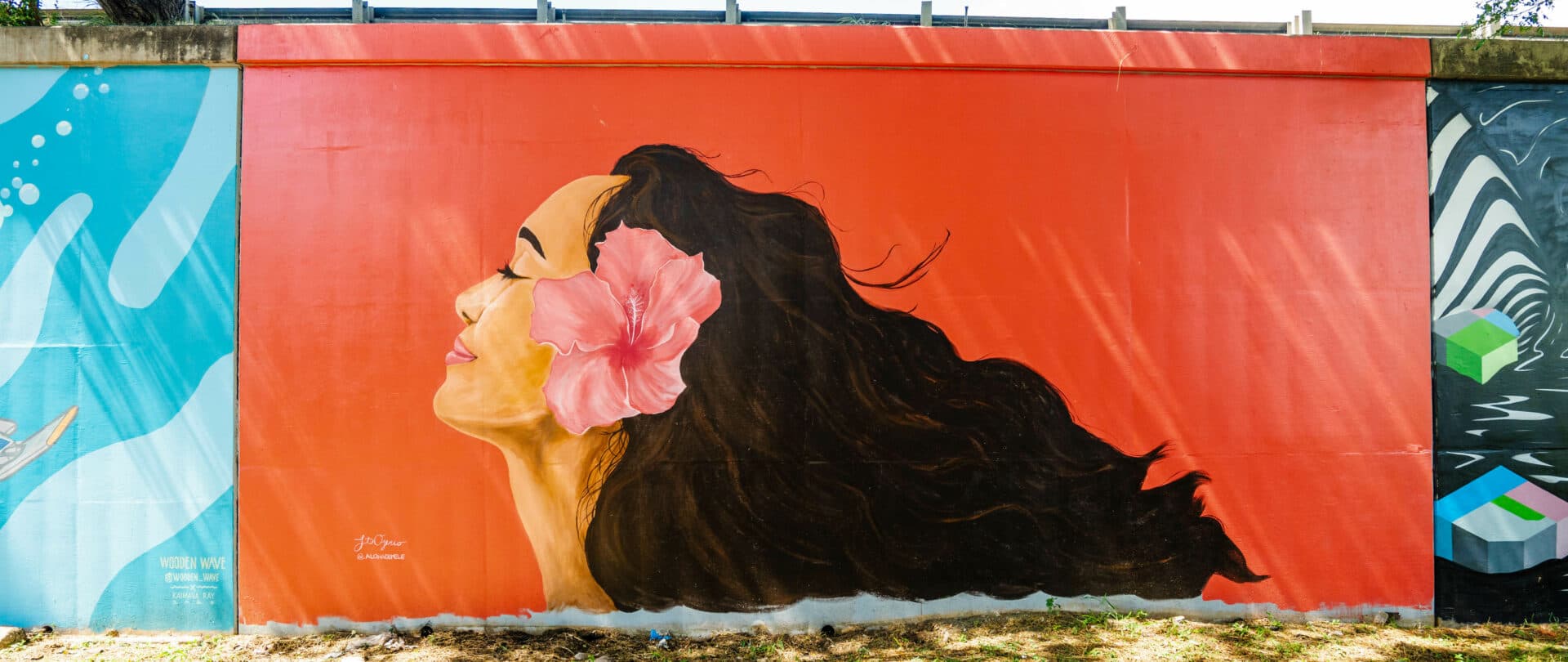
Aloha De Mele
From a hobby that grew out of boredom, J.T. Ojerio's art captures the beauty, culture and people of her island home.
BY Krystal Kakimoto
“If I can draw, so can you!” declares JT Ojerio, who works under the moniker Aloha de Mele. Her art may be sold in boutiques across the state, and have a distinctive, island style that makes her pieces instantly recognizable, but she still shrinks from the spotlight. Instead, she’s quick to point out this artist thing is a whole new world to her and identifying as a creative has taken some serious getting used to.
Growing up, she was the girl obsessed with judo, not drawing, preferring to spend her time learning about fitness, not frescoes. As a student at Punahou School (a private, college preparatory school in Honolulu), she was a state champ in wrestling, and her post-secondary career went on a similar trajectory: undergrad in Colorado and then earning a master’s degree in exercise physiology and a certificate in pain medicine in Chicago.
Art wouldn’t start to become a significant part of Ojerio’s life until 2017, when she was recovering from reconstructive surgery due to a hip injury. For once, she was forced to slow down; and for someone as active as her, that meant some big habit shifts. “My body was getting pretty beat up from doing personal group training and fitness. I’ve always had to be busy with my hands, so I was looking for something I could do sitting down in front of the TV and just chilling with my dog,” says Ojerio. “I only started drawing, honestly, out of boredom!” Drawing her pieces, with their subjects of elegant tropical flora and serene islander ladies gave her more than just something to do. It was an opportunity to connect with her home back in Hawai‘i when she was missing it more than ever.
Even though occupying herself with the therapeutic, healing powers of art turned out to be a big personal milestone during her time in Chicago, Ojerio didn’t think to translate it into something more until 2020. The tumultuous onset of covid-19 and being let go of her job created what would turn out to be a huge opportunity.
“I had a couple of drawings I had done just for fun. My coworkers, before I got let go, saw some of my drawings and were like, you should sell these,” remembers Ojerio. “I got a Shopify. And it really blew up from there.”
She speculates the timing could have been a lot of the reason why Aloha de Mele was instantly successful. With everything closed during the pandemic and people socially distancing, everyone was suddenly spending a lot more time at home, with a lot more money to burn. It makes sense that home improvement suddenly shot to the top of the national hobbies list. And Aloha de Mele’s style perfectly lends itself to the laid-back, island, jungalow style that local aesthetes are looking for. “I kind of want it to blend in with your life,” she explains.
For her, that means a lot of tropical botanicals taking center stage in stripped-down, simple compositions that pop as solo wall art but also as part of a gallery. Some of Ojerio’s most iconic and recognizable works are zoomed-in drawings of ladies’ loose hair buns charmingly disheveled and wild — the quintessential island girl uniform. Adorning these updos are bundles of local blooms fit for a hula performance, from chunky, dramatic orchids to playful gardenias, to sprigs of intricate lehua and pala‘a fern. An ombre glow of sunset shades emanates softly from the background.
Other pieces could be called, simply, studies in flowers: A standalone drawing of a golden yellow dwarf heliconia against a dramatically contrasting deep orange; the perfect monstera specimen, front and center with its Swiss cheese holes making a pretty effect against a white background; one single hibiscus viewed from above, ruffled petals fluttering outward in a breathtaking gradient of purple and vivid magenta, the dusty pinpricks of its yellow pollen so soft-looking you can almost feel it.
Ojerio’s true Hawai‘i roots also come into play, part of what sets Aloha de Mele apart from the banal, tourist-targeting “Hawai‘i” art pieces you’ll find from non-local sellers online. Her knowledge of lei, significant local flora and native Hawaiian language and practices shine through in the Aloha de Mele catalog. Her drawing of a pāpale (woven coconut frond hat) is one example, as is her print of a pū‘olo, a bundle wrapped with ti leaves usually intended as a gift or to commemorate a loved one. Ojerio’s quilt drawings, designed as a duo, are nods to traditional Hawaiian quilts, with their iconic symmetry and use of stylized, local plants.
Hawaiian mythology also appears as a theme in Aloha de Mele pieces. In one, the fire goddess Pele sleeps on a pile of her own deep, black hair, playfully arranged to look like a mountain of ridged lava rock. In another piece named Manō (Hawaiian for “shark”— which plays an important role in the Hawaiian pantheon), one of these majestic creatures is shown darting sleekly across the ocean floor.
More than the subjects of each piece, however, are the feelings they evoke: something distinctly Hawai‘i, with its balmy weather, outdoor adventure, lighthearted residents and tropical, beachy lifestyle. In other words? It’s evocative of everything there is to love about this island home. Namely, the beauty, culture and people — just the things Ojerio says inspires her.
That inspiration continues to help her grow as an artist; thanks to the open, supportive creatives she’s met in the local art scene. Recently, Ojerio had a chance to be a part of O’ahu’s World Wide Walls mural festival. Previously known as Pow! Wow! Hawai‘i, the event brings artists from all manner of styles, all across the island, together to create larger than life paintings in Honolulu’s urban spaces. It’s the ultimate intersection of art and community. And this year was a particularly significant milestone, marking the first time the event traded in its original locale in hip and trendy Kaka‘ako for Kalihi, a historically underserved and overlooked neighborhood that would benefit from the type of positive impact World Wide Walls is looking to make with its public art.
The project was a big departure for Ojeria, who is used to working digitally, and on a small scale. When founder and organizer Jasper Wong initially approached her about participating, “I didn’t have the heart to tell him, ok, but I’ve never painted before,” laughs Ojerio, who turned to another well-known local muralist in the community for help. “So, I got the number of Kamea Hadar, and he was giving me tips on how to blend, and what you should do when you put it on the wall. Thank god the first mural came out, because if not I would have been scarred for the rest of my life!”
The final piece, called “Leiolani”, is a dramatic rendering of a joyful, local woman with long, brown tresses in mid-toss. Her hair streams behind her, blowing in the wind, with one of Ojerio’s signature magenta hibiscus flowers placed in her ear.
Like many of her drawings, “Leiolani” is an homage to the powerful wāhine (women) in our lives. It’s a message that echoes beyond the image, into the work Ojerio does herself, work that is always pushing her to grow and learn as a female creative and entrepreneur. “Definitely, learning new mediums is empowering,” she says. “Being able to do murals is very empowering as well. I’m still going to stay true to my simple, ‘what-you-see-in-Hawai‘i’ drawings. But you know, coming up, [I’ll be] playing around and just thinking outside of the box too.J
